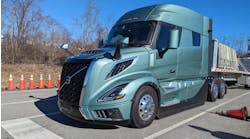Will the costs of autonomous commercial vehicle (ACV) technology in the trucking industry overshadow the benefits? Or will it prove to be the other way around, with fuel savings, driver lifestyle enhancement, and safety improvements outweighing the price tag of ACVs?
Global consulting firm Frost & Sullivan delved into those questions in a new study entitled The Strategic Outlook of Autonomous Heavy-Duty Trucks and found that some “price-sensitive” markets may be slow to adopt such technology, whereas in others – notably the long-haul trucking sector – may experience at minimum a return on investment (ROI) period of three years.
Wallace Lau, an industry analyst with the automotive & transportation practice at Frost & Sullivan toldAmerican Trucker Editor-at-Large Sean Kilcarr that a variety of ACV-related systems are already in use today within the trucking industry, such as electronic stability control (ESC), collision avoidance technology, rear- and forward-view camera systems, plus related electronic sensor arrays needed for transmitting data between such systems and a truck’s engine, transmission, and brakes.
“In fact we’re already seeing the use of true ACVs in the agricultural, defense and mining industries today,” he explained. “The key question is how OEMs will package and sell ACVs as a benefit to [trucking] fleets.”
Frost & Sullivan’s research indicates the incremental cost of ACV right now is around $30,000 compared to a “standard” truck operated by a human driver – an incremental cost that covers new sensors, telematics upgrades, human-machine interface (HMI) connections, driveline enhancements, and software algorithms.
While Frost & Sullivan predicts early-stage ACVs will see active use on North American roadways by 2025 – largely in “truck platooning” operation – the total incremental cost for autonomous driving technology in commercial vehicles won’t decline by more than 10%, largely due to information technology (IT) needs.
For the full analysis, see Kilcarr’s post on FleetOwner.com.

Voice your opinion!
Voice your opinion!
To join the conversation, and become an exclusive member of FleetOwner, create an account today!
Latest from In the Cab
Latest from In the Cab



